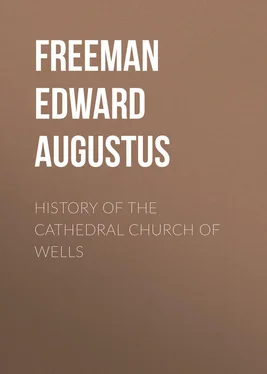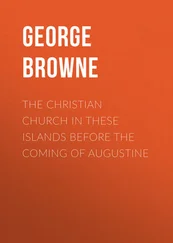Edward Freeman - History of the Cathedral Church of Wells
Здесь есть возможность читать онлайн «Edward Freeman - History of the Cathedral Church of Wells» — ознакомительный отрывок электронной книги совершенно бесплатно, а после прочтения отрывка купить полную версию. В некоторых случаях можно слушать аудио, скачать через торрент в формате fb2 и присутствует краткое содержание. Жанр: foreign_antique, foreign_prose, на английском языке. Описание произведения, (предисловие) а так же отзывы посетителей доступны на портале библиотеки ЛибКат.
- Название:History of the Cathedral Church of Wells
- Автор:
- Жанр:
- Год:неизвестен
- ISBN:нет данных
- Рейтинг книги:4 / 5. Голосов: 1
-
Избранное:Добавить в избранное
- Отзывы:
-
Ваша оценка:
- 80
- 1
- 2
- 3
- 4
- 5
History of the Cathedral Church of Wells: краткое содержание, описание и аннотация
Предлагаем к чтению аннотацию, описание, краткое содержание или предисловие (зависит от того, что написал сам автор книги «History of the Cathedral Church of Wells»). Если вы не нашли необходимую информацию о книге — напишите в комментариях, мы постараемся отыскать её.
History of the Cathedral Church of Wells — читать онлайн ознакомительный отрывок
Ниже представлен текст книги, разбитый по страницам. Система сохранения места последней прочитанной страницы, позволяет с удобством читать онлайн бесплатно книгу «History of the Cathedral Church of Wells», без необходимости каждый раз заново искать на чём Вы остановились. Поставьте закладку, и сможете в любой момент перейти на страницу, на которой закончили чтение.
Интервал:
Закладка:
I think then that, however our Bath neighbours may look at him, we at Wells have a right to set down Bishop John of Tours as the worst enemy that our church had from the eighth century to the sixteenth. We are told that he repented, but it must have been an ineffectual kind of repentance, as he made no restitution. 44 44 The Canon (p. 560) says, "Licet ipse confractus senio inde pœniteret, tamen ædificia canonicorum destructa minime reparavit, nec fundum eis injuste ablatum restituit." But the Historiola seems to imply at least a purpose of restitution, as its words are, "Pœnitentiâ ductus de sacrilegio perpetrato, resipuit et pœnituit, et pœnitentiam suam scriptam reliquit. Johannes vero Archidiaconus terras quas pater suus obtinuerat per hæreditatem et præposituram canonicorum nihilominus sibi usurpavit."
Or we may say that his repentance was geographical, for a deed is extant in which he restores to the monks of Bath all that he had taken from them, but there is no sign that he restored anything to the Canons of Wells. 45 45 The Charter is printed in the Monasticon, ii. 268.
Still his doings had one effect; the Lotharingian discipline was broken up for ever, and the secular priests of Wells were never again constrained to sleep in a common dormitory or to dine in a common refectory. John thus indirectly helped to put things on the footing which they assumed under the next Bishop but one, and which, in its main features, has been retained to this day. It is that Bishop, Robert by name, whose episcopate forms the natural boundary of the first portion of my subject. Hitherto I have had to deal with a church and a Chapter of Wells; but hardly with the church and Chapter which at present exist. I have had to speak of the early beginning of things, of fabrics and institutions alike which were far from having reached their full developement. With Robert a new era begins alike in architectural, capitular, and municipal matters. He was a founder in every sense. He rebuilt the fabrics of both his churches. He settled the relations between those two churches as they remained till the suppression of the monastery of Bath in the sixteenth century. He gave the Chapter of Wells a new constitution, which, with some changes in detail, it still retains. Last, but not least, he gave the first charter of incorporation to the burghers who had gradually come to dwell under the shadow of the minster. He may therefore be looked upon as the founder of Wells, church and city alike, as they now stand. The reign of this memorable Prelate therefore marks the first stage in my story; I will therefore now bring my first lecture to an end, and will reserve a detailed account of the important episcopate of Robert to form the beginning of my account of the mediæval, as distinguished from the early, history of the church of Wells.
LECTURE II
In my former Lecture I did my best to trace the history of the church of Wells from the earliest days. We have seen its small beginnings, a colony of priests planted in a newly-conquered land, with their home fixed on a small oasis between the wild hill-country on the one side and the never-ending fen on the other. There their church had risen, and settlers had gathered round it; it had grown into the seat of a Bishop, the spiritual centre of the surrounding country, a rival in fame and reverence of that great island church which stood as a memorial of the past days of the conquered, while Wells rose as a witness of the presence of the conquerors. We have seen one Prelate of foreign birth at once vastly increase the power and revenues of his see and try to subject his clergy to the yoke of a foreign rule against which the instincts of Englishmen revolted. We have seen another foreigner undo the work of his predecessor alike for good and for evil; we have seen him forsake church and city altogether, and remove his episcopal chair to a statelier and safer dwelling-place. We have seen the local foundation again brought back to a state lower than the poor and feeble condition out of which Gisa had raised it. We now come to the great benefactor whom we may fairly look upon as the founder of Wells as it is, the man who put the Bishoprick and Chapter into the shape with which we are all familiar, and who moreover gave to the city its first municipal being.
On this last head I shall not enlarge. The subject is so completely the property of others both present and absent that I should feel myself the merest intruder if I attempted to dwell upon it. I will rather go on with those parts of Bishop Robert's career which more directly concern my subject, and look at him in three lights, as his actions concern respectively the Bishoprick, the Chapter, and the fabric of the church.
After the death of John of Tours the see was held by one Godfrey, a countryman of Gisa's from Lower Lorraine, and therefore somewhat nearer to an Englishman than a mere Frenchman like John. His promotion was owing to his being a chaplain of the Queen, Henry the First's second wife, Adeliza of Löwen, with whom he had doubtless come into England. 46 46 The Historiola and the Canon both call Godfrey simply "Teutonicus;" but it appears from the Continuator of Florence of Worcester (ii. 78) and from the Annals of Waverley (Ann. Mon. ii. 219) that he was Chancellor to Queen Adeliza. We can hardly doubt that he was one of her countrymen from the Netherlands.
He is described as being of noble birth, mild, and pious, but perhaps mere mildness was not the virtue which was most needed in those days. All that we hear of him is that he tried to get back the Canons' lands from John the Archdeacon, but that King Henry and Roger Bishop of Salisbury, who was a mighty man in those days, hindered him. He died in 1135. Then came Robert. He was a rare case of a Bishoprick in those times being held by a man who could be called in any sense an Englishman. As a rule, the great ecclesiastical offices were now given to men who were not only not of Old-English descent, but who were not even the sons of Normans or other strangers settled in England. Utter foreigners, men born on the Continent, were commonly preferred to either. But Robert was a Fleming by descent and born in England. As a native of the land, and sprung from one of those foreign nations whose blood and speech is most closely akin to our own, we may welcome him a countryman, in days when the most part of the land was parcelled out among men who did not even speak our tongue. He had been a monk at Lewes at Sussex, and was promoted by the favour of Henry of Blois, Bishop of Winchester, the famous brother of King Stephen. Henry had been Abbot of Glastonbury before he became Bishop, and, what is more, he kept the Abbey along with his Bishoprick. He is said to have sent for Robert to look after the affairs of the monastery; that is, I suppose, to act as his deputy after he became Bishop. 47 47 This account of him is given both by the Historiola and by the Canon (Angl. Sacr. i. 561), who gives as a reason for his mission to Glastonbury, "eo quod non recte eorum aratra incedebant." His birth comes from the Continuator of Florence (ii. 95), who says that he was "Flandrensis genere, sed natus in partibus Angliæ."
Thus we see that the comfortable practice of pluralities, and what somebody calls the "sacred principle of delegation," – that is to say, the holding two or more incompatible offices and leaving their duties to be done by others or not to be done at all, – are inventions in which the nineteenth century was forestalled by the twelfth. Robert next from deputy Abbot of Glastonbury became Bishop of Bath, and he seems to have set himself manfully to work to bring his diocese and its two head churches out of the state of confusion into which the changes of John of Tours had brought them. First of all with regard to the Bishoprick. You understand of course that the removal of the see from Wells to Bath had been made without the consent of the Canons of Wells, who had an undoubted right to be consulted about the matter. In ecclesiastical theory a Bishop and his Chapter are very much like a King and his Parliament; neither of them can do any important act without the consent of the other. And here a thing had been done for which of all others the consent of the Wells Chapter ought to have been had, as their most precious rights had been taken away from them. All this time they had never formally submitted to the change, and they had been always complaining of the wrongful removal of the see, and asserting their own rights against the usurpations of the monks of Bath. And it is to be noticed that the change had never been approved or recognized by any Pope. The Bishops of Somersetshire were still known in official language at Rome as Episcopi Fontanenses or Bishops of Wells, not as Episcopi Bathonienses or Bishops of Bath. Robert now procured that the episcopal position of Bath should be recognized, and from this time for some while after our Bishops are commonly called Bishops of Bath. 48 48 Historiola, p. 25.
But it would seem that this is merely a contracted form, for the style of Bishop of Bath and Wells, with which we are all so familiar, is found before very long. And there can be no doubt that the controversy was now settled by Robert on these terms, that Bath should take precedence of Wells, but that the Bishop should have his throne in both churches, that he should be chosen by the monks of Bath and the Canons of Wells conjointly, or by deputies appointed by the two Chapters, and that those episcopal acts which needed the confirmation of the Chapter should be confirmed both by the Convent of Bath and by the Chapter of Wells. 49 49 See the agreement in Wharton's note, Anglia Sacra, i. 561.
There are deeds hanging up in this very room to which you will see the confirmation of both those bodies. The Bishop of Somersetshire thus had two cathedral churches, as was also the case with the Bishop of Coventry and Lichfield, and as has been the case with the Bishop of Gloucester and Bristol since those sees were joined within our own memory. This arrangement lasted till the cathedral church of Bath was suppressed under Henry the Eighth, after which, by an Act of Parliament passed in 1542, the Chapter of Wells was made the sole Chapter for the Bishop. 50 50 The Act is printed in the Monasticon, ii. 293.
Things thus came back, as far as Wells was concerned, to much the same state as they had been in before the changes of John of Tours, except that Bath still forms a part of the Bishop's style. But since the Act of Henry the Eighth it has been a mere title, as the Bishop is Bishop of Bath in no sense except that in which he is Bishop of Taunton or of any other place in the diocese. He is elected by the Chapter of Wells only; he is enthroned in the church of Wells only; and when Saint Peter's church at Bath was set up again in the reign of James the First, it was not as a cathedral, but as a simple parish church.
Интервал:
Закладка:
Похожие книги на «History of the Cathedral Church of Wells»
Представляем Вашему вниманию похожие книги на «History of the Cathedral Church of Wells» списком для выбора. Мы отобрали схожую по названию и смыслу литературу в надежде предоставить читателям больше вариантов отыскать новые, интересные, ещё непрочитанные произведения.
Обсуждение, отзывы о книге «History of the Cathedral Church of Wells» и просто собственные мнения читателей. Оставьте ваши комментарии, напишите, что Вы думаете о произведении, его смысле или главных героях. Укажите что конкретно понравилось, а что нет, и почему Вы так считаете.












